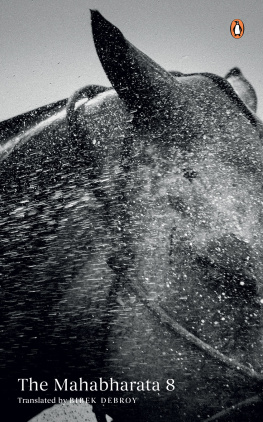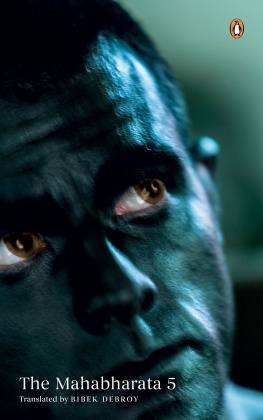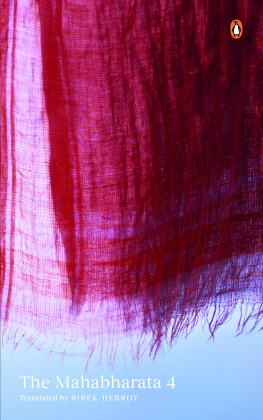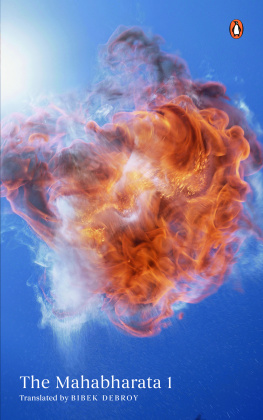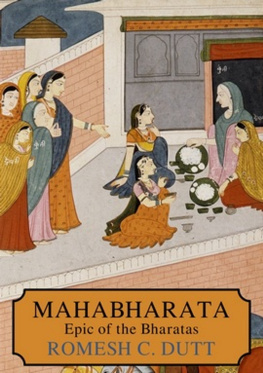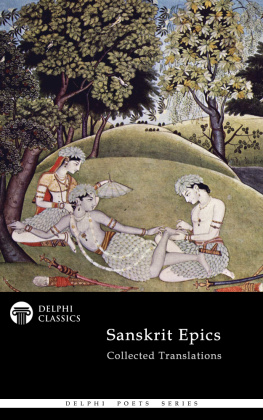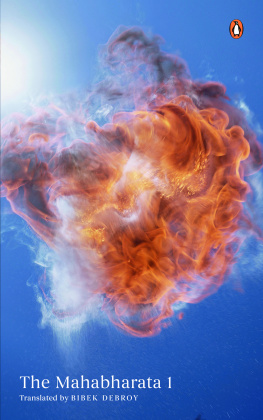Shalom - Re-ending the Mahabharata: the rejection of dharma in the Sanskrit epic
Here you can read online Shalom - Re-ending the Mahabharata: the rejection of dharma in the Sanskrit epic full text of the book (entire story) in english for free. Download pdf and epub, get meaning, cover and reviews about this ebook. City: New York;Albany, year: 2017, publisher: State University of New York Press, genre: Romance novel. Description of the work, (preface) as well as reviews are available. Best literature library LitArk.com created for fans of good reading and offers a wide selection of genres:
Romance novel
Science fiction
Adventure
Detective
Science
History
Home and family
Prose
Art
Politics
Computer
Non-fiction
Religion
Business
Children
Humor
Choose a favorite category and find really read worthwhile books. Enjoy immersion in the world of imagination, feel the emotions of the characters or learn something new for yourself, make an fascinating discovery.
- Book:Re-ending the Mahabharata: the rejection of dharma in the Sanskrit epic
- Author:
- Publisher:State University of New York Press
- Genre:
- Year:2017
- City:New York;Albany
- Rating:3 / 5
- Favourites:Add to favourites
- Your mark:
- 60
- 1
- 2
- 3
- 4
- 5
Re-ending the Mahabharata: the rejection of dharma in the Sanskrit epic: summary, description and annotation
We offer to read an annotation, description, summary or preface (depends on what the author of the book "Re-ending the Mahabharata: the rejection of dharma in the Sanskrit epic" wrote himself). If you haven't found the necessary information about the book — write in the comments, we will try to find it.
Shalom: author's other books
Who wrote Re-ending the Mahabharata: the rejection of dharma in the Sanskrit epic? Find out the surname, the name of the author of the book and a list of all author's works by series.
Re-ending the Mahabharata: the rejection of dharma in the Sanskrit epic — read online for free the complete book (whole text) full work
Below is the text of the book, divided by pages. System saving the place of the last page read, allows you to conveniently read the book "Re-ending the Mahabharata: the rejection of dharma in the Sanskrit epic" online for free, without having to search again every time where you left off. Put a bookmark, and you can go to the page where you finished reading at any time.
Font size:
Interval:
Bookmark:

Re-ending the
Mahbhrata
SUNY series in Hindu Studies
Wendy Doniger, editor
Re-ending the
Mahbhrata
The Rejection of Dharma in the Sanskrit Epic
NAAMA SHALOM

Published by State University of New York Press, Albany
2017 State University of New York
All rights reserved
Printed in the United States of America
No part of this book may be used or reproduced in any manner whatsoever without written permission. No part of this book may be stored in a retrieval system or transmitted in any form or by any means including electronic, electrostatic, magnetic tape, mechanical, photocopying, recording, or otherwise without the prior permission in writing of the publisher.
For information, contact State University of New York Press, Albany, NY
www.sunypress.edu
Production, Eileen Nizer
Marketing, Michael Campochiaro
Library of Congress Cataloging-in-Publication Data
Names: Shalom, Naama, 1974 author.
Title: Re-ending the Mahabharata : the rejection of dharma in the Sanskrit epic / By Naama Shalom.
Description: Albany : State University of New York Press, 2017. | Series: SUNY series in Hindu studies | Includes bibliographical references and index.
Identifiers: LCCN 2016031427 (print) | LCCN 2017003754 (ebook) | ISBN 9781438465012 (hardcover : alk. paper) | ISBN 9781438465036 (e-book)
Subjects: LCSH: MahbhrataCriticism, interpretation, etc. | Dharma.
Classification: LCC BL1138.27 .S48 2017 (print) | LCC BL1138.27 (ebook) | DDC 294.5/923046dc23
LC record available at https://lccn.loc.gov/2016031427
10 9 8 7 6 5 4 3 2 1
For
Yohanan Grinshpon, a mahtm and mahguru
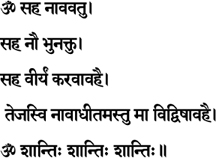
nti mantra, Taittirya Upaniad 2
In Hinduism, there are three a s (debts) that one must repay in the course of ones life: those due to the gods; those due to teachers; and those due to ones ancestors. Although the acknowledgment section of a book can hardly settle all these debts, one feels somewhat assured by recognizing them with awe. For, indeed, no achievementno matter how smallis possible without the help of benevolent souls. I am greatly indebted to Christopher Minkowski, who supervised my work as a doctoral researcher at the University of Oxford. I gained immeasurable knowledge from him and am truly grateful for his punctual, thorough, and illuminating reading of my work during its various stages.
This book was born long before it was even conceived. Behind this statement there exists a dream I once dreamt about the ending of this great epic that disturbed my mind profoundly for many long months. The dream was about an Indiana Jones sort of discovery of a mysterious and dusty text in far-away India. Knowledge of the discovery in my dream was shared by one of my most revered teachers, David Shulman. Besides his many unparalleled qualities, he has the singular ability to demonstrate to his students how to nurture their imagination and to achieve their loftiest and most spectacular dreams. I owe him endlessly for his support and inspiration.
Another significant seed that finally flowered with the writing of this book was planted, as it were, in a seminar of Yohanan Grinshpon on the Mahbhrata , many years ago at the Hebrew University of Jerusalem. My sincere gratitude goes to him for teaching me something fundamental about research, namely, if one is sufficiently patient and receptive to cultivating open-ended questions, these will eventually, often miraculously, turn raw material into something tangible and of great potential. His tremendous creativity has never ceased to arouse my curiosity, and his influence is undoubtedly felt in every commendable idea this book has to offer.
This study was facilitated by the support of several institutions and funding bodies. I am extremely grateful to the Oxford University Clarendon Fund, Balliol College, the Oxford Oriental Institute, and the Oxford Centre for Hindu Studies. I would also like to express my sincere gratitude to State University of New York Press and the head editor of SUNYs series in Hindu Studies, Wendy Doniger, for appreciating the potential of this work and enabling it to come to print.
Last, I would like to thank several people who contributed to this book and its author in various ways: Keralas Oriental Research Institute and Manuscripts Library, and in particular, Mr. Shaji, the head librarian, for professional and generous service in locating and photocopying the text I (perhaps dreamt about and) eventually discovered (the Bhrataprabandha ); Nagaraja Rao, for a memorable and extremely enlightening initial reading experience of the Bhrataprabandha in Mysore; Arik Moran, for helpful comments on earlier drafts of this book and, on numerous occasions, for understanding better than I did what I was trying to say; Lindsay Talmud, for professional, insightful and dedicated editing; and my mother, Sarah Shalom, who deserves, as always, profound appreciation that goes beyond words.
In Sanskrit as in English, the word anta or end has two distinct sets of meaning. It connotes both ending, conclusion, culmination and also aim, objective, purpose. Little wonder that humans have established a semantic connection between these meanings.
The end of a journey is in fact its farthest destination point as well as its objective. The end of a book or a movie often heightens ones impression of the composition as a whole. The crux of thrillers and related genres, for instance, is to withhold the resolution of the suspense until the very end, thereby imparting a memorable, at times riveting, visual experience to the viewers. And thoughts about the end of life, the climax of all climaxes, the ultimate destination, are generally repressed because awareness of ones own ending is terrifying while going about ones daily tasks. Knowing that the aim of life is its end necessitates a prolonged mindfulness to determine either its beauty or its wretchedness. Whether we acknowledge it or not, our own ending inherently shapes the course of our lives, our actions, choices, and the way we feel about the world. The idea of our own finality lurking in the back of our minds is probably the most crucial yet most suppressed aspect of our existence. Thus, the premise at the basis of aesthetic experience and of human life in general appears, simply, to be, that endings matter. This same premise defines the larger issues with which this book is concerned.
Perhaps intuitively sensing the quality of ends double meaning (conclusion/aim), some readers begin perusing a book by unapologetically flipping straight to the very last pages. Whether stemming from practical reasons of determining whether this is a work worthy of ones time, propelled by mere curiosity, or even impelled to rid oneself of the somewhat pestering tension associated with the unknown, it is quite clear that endings (indeed, as well as beginnings) uniquely matter. The same readers who take an unorthodox approach to reading will undoubtedly find the great Sanskrit epic, the Mahbhrata (henceforth: MBh), to be a work that further challenges inclinations of this kind.
Right from the outset, the MBh informs its readers that besides the customary order of reading, that is, starting at the beginning and finishing at the end, the reading of this book may be commenced at several, equally valid, opening points. This statement, which indicates that this long book actually has multiple beginnings, naturally implies various endings as well. In other words, if standard rules were ever set as regards how a story should be delivered (most commonly, the typical construction of beginning, middle, and end), then this particular story would seem to transgress these principles in almost every conceivable way. These features of the MBhs unique storytelling raise several questions that this book addresses: how does a text, so very long (perhaps the longest among epic texts) and intricately complex, as the MBh, find a finishing point? Can it truly reach a conclusion, or is that beyond the bounds of its genre? Finally, since it does somehow end, because we know that in the most literal sense its narrative does eventually terminate, what significance does this ending have when weighed against the narratives hefty body as a whole?
Font size:
Interval:
Bookmark:
Similar books «Re-ending the Mahabharata: the rejection of dharma in the Sanskrit epic»
Look at similar books to Re-ending the Mahabharata: the rejection of dharma in the Sanskrit epic. We have selected literature similar in name and meaning in the hope of providing readers with more options to find new, interesting, not yet read works.
Discussion, reviews of the book Re-ending the Mahabharata: the rejection of dharma in the Sanskrit epic and just readers' own opinions. Leave your comments, write what you think about the work, its meaning or the main characters. Specify what exactly you liked and what you didn't like, and why you think so.

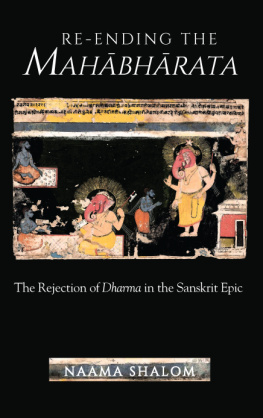
![Krishna Dharma - Mahabharata: [the greatest spiritual epic of all time]](/uploads/posts/book/213378/thumbs/krishna-dharma-mahabharata-the-greatest.jpg)

